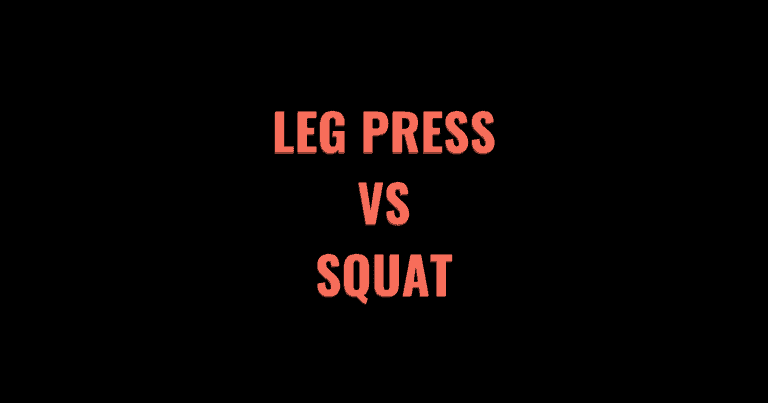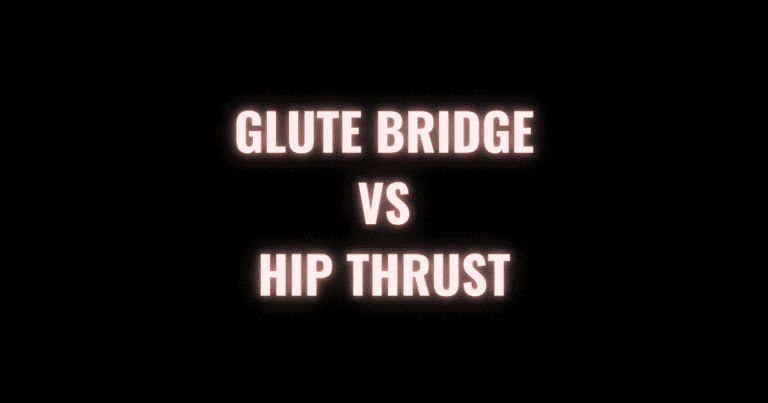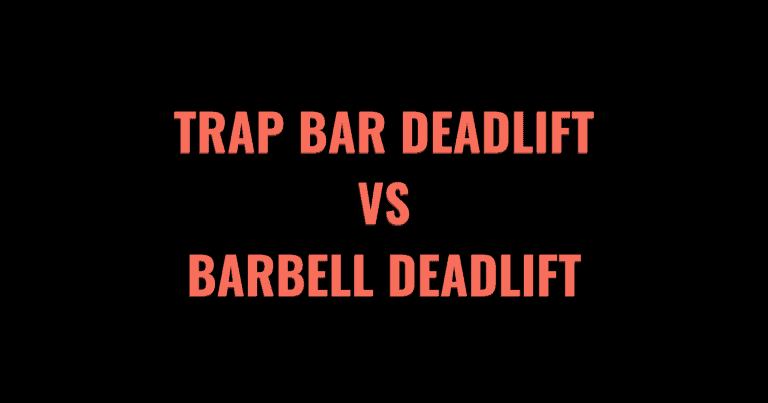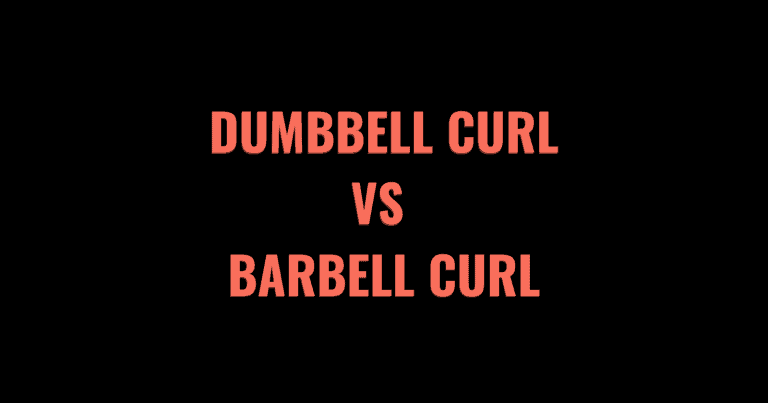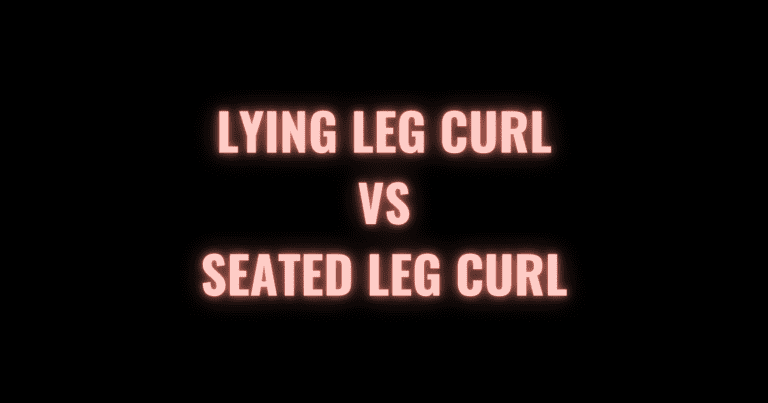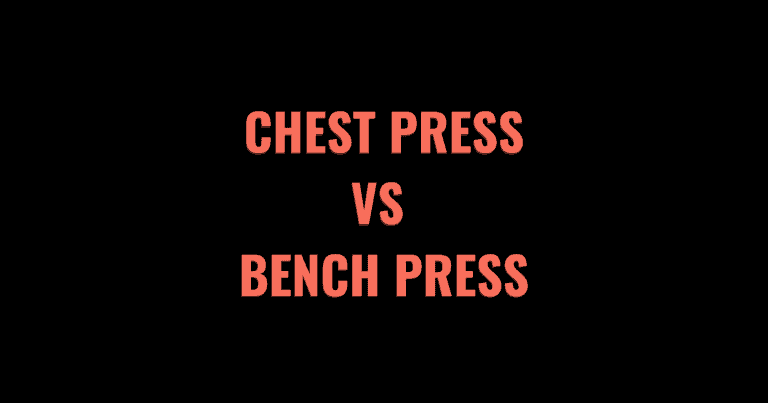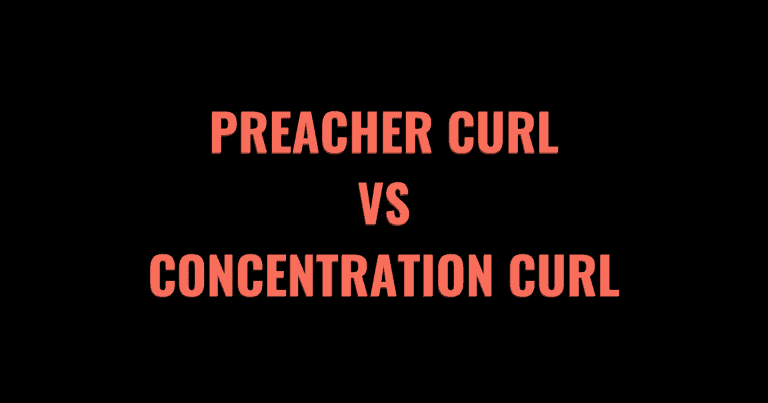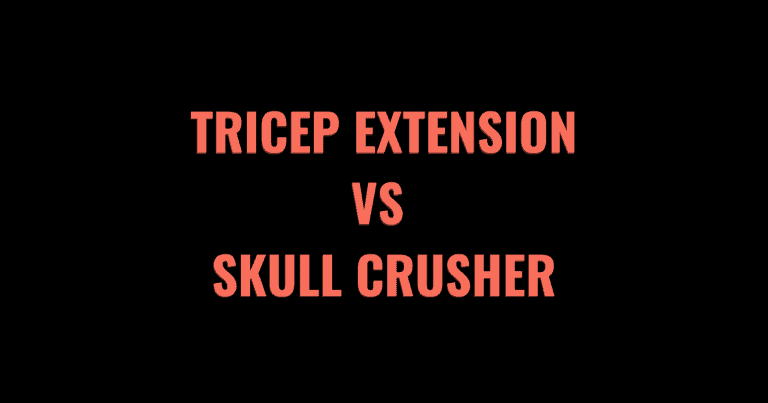Bicep curls are one of the most well-known upper body exercises. If you’ve been lifting for a while, chances are you have tried at least one type of curling exercise.
But with so many different variations, it can be difficult to know which type is best suited for your needs and goals. Should you use dumbbells, a straight barbell, or an EZ bar to get the most out of your session and maximize bicep growth?
Below, we’ll go over two common types of barbell bicep curl variations: the straight bar curl and the EZ bar curl to help you decide which exercise is right for you.
Table of Contents
- 1 EZ Bar Curl vs Straight Bar Curl
- 2 Straight Bar Bicep Curl vs. EZ Curl: Pros and Cons
- 3 Straight Bar Curl vs. EZ Bar Curl – Muscles Used
- 4 Form Differences
- 5 Helpful Form Cues
- 6 Common Form Mistakes
- 7 Frequently Asked Questions
- 8 Other Exercise Comparison Posts
- 8.1 Leg Press vs. Squat: Differences, Pros, and Cons
- 8.2 Romanian Deadlift vs Deadlift: Which is Better?
- 8.3 Floor Press vs. Bench Press: Pros, Cons, and Differences
- 8.4 Rack Pulls vs. Deadlifts: Differences, Pros, and Cons
- 8.5 Glute Bridge vs Hip Thrust: Differences & Benefits
- 8.6 Trap Bar Deadlift vs. Barbell Deadlift: Is One Better?
- 8.7 Barbell Curl vs Dumbbell Curl: Benefits & Differences
- 8.8 Lying Leg Curl vs Seated Leg Curl: Pros & Cons
- 8.9 Bench Press vs Chest Press: Pros and Cons
- 8.10 Leg Press vs Hack Squat: Differences & Benefits
- 8.11 Preacher Curl vs Concentration Curl: Which is Better?
- 8.12 Tricep Extension vs Skull Crusher: Pros and Cons
EZ Bar Curl vs Straight Bar Curl
What is the main difference between a straight bar curl and an EZ bar curl?
The main difference between an EZ bar curl and a straight bar curl is which muscles are used. The straight bar forces the arm into a more supinated position, isolating the biceps brachii. The EZ bar has the hands in a slightly more neutral position, engaging the brachialis and brachioradialis to a greater degree.
Another key difference is the equipment required for each movement. Bicep curls using a straight barbell lock your wrists into a supinated (palms facing forward) position throughout the exercise. EZ bars are designed with a zig-zag or curve near the knurling to provide a range of grip variations that target the muscles from multiple angles.
Performing a bicep curl with a regular straight bar or an EZ curl bar can both help build bigger, stronger biceps. The slightly pronated grip used with the EZ curl bar will also help target the brachialis, which can create a taller, more “peaked” look for the bicep.
Ultimately, the decision should come down to which is more comfortable. If both are comfortable, then either can be used effectively.
Here’s Jim Stoppani with a quick breakdown of the key differences between performing bicep curls with an EZ Curl bar and a straight bar.
Straight Bar Bicep Curl vs. EZ Curl: Pros and Cons
The best type of barbell bicep curl for you will depend on your experience level, your access to equipment, and how comfortable certain grips feel for your body. Here are some of the pros and cons of straight bar curls and EZ bar curls to help you decide which to include in your training session.
Straight Bar Bicep Curl Benefits
Here are some of the advantages of straight bar curls.
- Engages both functions of the biceps. To maximize the effectiveness of your bicep curl, you want to make the muscle work as hard as possible. The biceps brachii serves two main purposes: to pull the forearm towards the shoulder and to supinate the forearm. The straight bar curl locks your hands in a supinated position throughout the exercise, increasing muscle engagement through a full range of motion. This may help to maximize muscle hypertrophy.
- Easy to load with heavy weight. Using a standard barbell for your bicep curl offers an almost unlimited amount of progression. You can stack a lot of weight onto a straight barbell, and even set up your curls in the squat rack to save energy when setting up to use during your set (as long as no one is using the squat rack to squat!)
- Encourages strict form. Straight bar curls lock your arms into position so that you can’t shift your grip during the set. It also inhibits using momentum, as the bar will stop when it hits your thighs. This helps you maintain strict form without moving your elbows or generating momentum from the legs.
- More functional and complex. Curling a straight bar doesn’t just tax the biceps. It engages several other muscles to lift the barbell with proper form. Straight barbell curls will help you build your forearm and grip strength and become stronger in the fully supinated grip position.
- No need for additional equipment. Many lifters are working with a limited amount of equipment, especially those training at home or in a less well-equipped gym. Being able to use the same barbell for your squats, presses and curls is efficient and can save time, money, and gym space.
Straight Bar Curl Drawbacks
Here are some of the drawbacks of straight bar curls.
- Shorter range of motion. During a straight bar bicep curl, some lifters will not be able to reach a full range of motion, as the bar will get in the way when it reaches your torso. Limiting the ability to fully contract the bicep may limit muscle activation.
- May cause wrist discomfort. Barbell curls force the palms to stay in a supinated position for the entire set. This can be great at targeting the biceps, but if you aren’t used to lifting weight from that position it can cause pain in the wrists and forearms.
- Less engagement of the brachialis and the brachioradialis. Straight bar curls are great at isolating the biceps brachii thanks to the fully supinated position of the hands. The downside is that it is slightly less effective at engaging the secondary muscles of the brachialis and the brachioradialis.
EZ Bar Curl Benefits
Here are some of the advantages of performing bicep curls with an EZ curl bar.
- Less strain on the wrists and forearms. The zig-zag in the EZ curl bar allows you to perform the bicep curl with a slightly more neutral grip. This will be more comfortable for people lacking wrist mobility and help reduce the risk of injury.
- Greater range of motion. The shape of the EZ bar allows you to contract the biceps more fully, as your hands can get closer to your body without the bar getting in the way. This may help to engage the muscle fibers more in the concentric (raising) and eccentric (lowering) phases of the lift.
- Engages the brachialis and the brachioradialis. The hand position in an EZ bar curl is better at targeting the lesser-known supporting muscles of the upper arm. The brachialis is located between the triceps and the biceps, and the brachioradialis connects the upper arm to the forearm. Strengthening these muscles can help to build a more well rounded and functional upper body.
- Less balance is required. The EZ bar is typically lighter and shorter than the standard barbell. This means the weight on either side will be closer to your body, eliminating some of the balance required to keep the barbell steady so you can focus all your attention on engaging your biceps.
EZ Bar Curl Drawbacks:
Here are some of the drawbacks of EZ bar curls.
- Potentially less bicep activation. EZ bars put the wrists and elbows in a slightly less supinated position. This can be more comfortable for some lifters, but it also means you are not as supinated and therefore may not isolate the biceps as effectively.
- Difficult to lift as much weight. The straight bar is typically easier and simpler to load with a heavier weight. If you are an advanced lifter, you may find you can’t load the EZ bar as heavy as you need to get your sets close to failure. Training with adequate intensity (often measured by tracking reps in reserve [RIR]) is important for triggering muscle growth, especially among trained lifters.
- It may not always be accessible. It’s unlikely that you will walk into a gym and be unable to find a single standard barbell. But, for example, if you are training in a new gym whilst travelling, you may not always be able to find an EZ curl bar.
Should You Use a Straight Barbell or an EZ Curl Bar for Bicep Curls?
When to do a straight bar curl
If you are comfortable in a fully supinated position and want to isolate the biceps, the straight bar curl should meet all your needs. Straight bar curls are likely the best choice for people wanting to lift maximal amounts of weight to target their biceps.
If you have limited access to equipment, getting used to a straight barbell for your bicep curls can also save you time, money, and space.
When to do an EZ bar curl
If you have any wrist, elbow or forearm pain in a straight bar curl, an EZ bar curl may be better suited for you. It will still be a great bicep workout, and won’t lead to you becoming injured and unable to train at all.
EZ bar curls also have an advantage in targeting the brachialis and brachioradialis, creating a rounded, fuller bicep that is also more stable and functional.
Straight Bar Curl vs. EZ Bar Curl – Muscles Used
The straight bar curl and the EZ bar curl are very similar movements that primarily target the biceps brachii. The straight bar forces the arm into a more supinated position, isolating the biceps brachii. The EZ bar has the hands in a slightly more neutral position, engaging the brachialis and brachioradialis to a greater degree.
Straight Bar Curl Muscles Used
- Primary: Short head of the Biceps Brachii
- Secondary: Long head of the biceps brachii, Brachioradialis, Brachialis, Deltoid, Wrist Extensor Muscles and Wrist Flexion Muscles, Forearm Flexors
EZ Bar Curl Muscles Used
- Primary: Short head of the Biceps Brachii
- Secondary: Brachioradialis, Brachialis, long head of the Biceps Brachii, Deltoid, Wrist Extensor Muscles and Wrist Flexion Muscles, Forearm Flexors
Form Differences
The primary difference between a straight bar curl and an EZ bar curl is the position of the hands. In both exercises, the barbell follows a very similar movement path and engages the same muscle groups.
How to do a straight bar curl with proper form
- Stand up straight with your feet about shoulder-width apart.
- Grab your loaded straight bar with your palms facing outward (supinated grip) and your hands roughly in line with your feet.
- Tuck your elbows in close to your torso and brace your core.
- Lift the barbell towards your chest by squeezing and contracting your biceps.
- Pause for a second at the top of the lift.
- With control, release the barbell back to its starting position.
- Repeat for the desired number of repetitions before resetting at the end of your set.
For a visual example, check out this video demonstrating the correct form for a straight barbell curl.
How to do an EZ bar curl with proper form
- Stand straight with your feet shoulder-width apart.
- Grab your loaded EZ bar along the curved section around the knurling.
- Tuck your elbows close to your body and set your shoulders back.
- Squeeze your biceps to lift the barbell towards you, aiming to touch your forearms to your bicep to ensure full contraction.
- Pause at the top of the curl.
- Release the bar to its starting position slowly and with control. Avoid letting it ‘bounce’ off your thighs to create momentum.
- Repeat for the desired number of reps.
This video from Scott Herman Fitness provides a helpful visual of how to perform the EZ bar curl.
Helpful Form Cues
Straight Bar Curl Form Cues
- Tuck your elbows close to the body. Your elbows should be pinned tightly to your torso. Think about keeping your elbows pointing towards the ground throughout the exercise to keep them from splaying outwards and ensure you isolate the bicep.
- Squeeze the bar with your hands. Gripping the barbell tightly with your hands and fingers will lock the bar in place and activate the forearm and bicep muscles. Gripping the bar tightly can also help prevent the elbows from flaring out.
- Lock in your shoulders. To fully engage the biceps, your shoulders should not move during your set. Pull them back and down away from your ears. Allowing them to travel up can place strain on your upper traps and cause dysfunctional movement patterns and discomfort.
- Hold at the point of maximum contraction. It is easy to start rushing when you get tired, especially during the eccentric (lowering) phase of the movement. Pause for a second or two at the top of the exercise and focus on lowering it slowly and with control.
EZ Bar Curl Form Cues
- Maintain tension in the wrists. EZ bars allow a more natural, neutral grip, but it is still important to protect this delicate joint. Warm up your wrists and make sure to keep them active when lifting and lowering the bar.
- Keep your elbows tucked and your hands just in front of your hips. Keeping your arms locked in place will help ensure your shoulders stay stable throughout your set. Keep your hands just in front of you to guide your range of motion and prevent you from using your legs to create momentum.
- Control the eccentric. Get the most out of the exercise by slowing down the lowering phase of the lift to give the muscle more time under tension.
- Look straight ahead. Resist the temptation to drop your head to look at the ground or the barbell. Keeping your neck long and chin high is important to protect the upper spine.
Common Form Mistakes
Straight bar curl form mistakes
- Not moving through a full range of motion. Many lifters accidentally start to perform partial reps in a barbell curl. Aim for maximum contraction at the top of the lift, and check your form by using a spotter or filming yourself to ensure proper technique.
- Swinging the elbows. Ensure you are isolating the biceps by being careful not to swing the elbows upward to initiate the lift. Lock your elbows in place to avoid generating momentum and keep the movement controlled.
- Overshooting your weight. The barbell curl is a great movement for lifting as much weight as possible. Unfortunately, this can lead many lifters to ‘ego lift,’ or increase the weight beyond what they can lift with proper form. If your form starts to slip, reduce the weight.
EZ Bar Curl Form Mistakes
- Leaning back to create momentum. The EZ bar allows you to get the barbell closer to your body, which can make it easier to generate momentum. Avoid leaning back to swing the bar towards you, or rocking forward to bounce the bar off your legs in the eccentric phase.
- Performing half reps. The great range of motion is one of the benefits of using an EZ bar, but only if you use it properly. Ensure the barbell rests near your thighs at the start of the movement and comes up high enough that your forearms and biceps make contact with each other.
Frequently Asked Questions
Bicep curl variations all primarily target the biceps, so you can choose a variation based on preference. Researchers conducting a 2018 study detected greater activation of the biceps brachii and the brachioradialis in an EZ bar curl compared to the straight bar curl. Others believe that the full supination and greater ability to overload the straight barbell make it a better choice for bicep hypertrophy. The best way to choose which bicep curl to do is to try them out and see what is most comfortable and which yields the best results for your body.
To increase your range of motion and protect the wrist and elbow joints, a curved or EZ bar may be a better choice. You should also use an EZ bar if you want to target the brachialis and brachioradialis more during the lift.
If you want to lift as heavy as possible and isolate the biceps brachii, the straight barbell curl is probably a great choice for you, as long as you feel comfortable in a fully supinated grip.
Barbell and dumbbell curls both have pros and cons for building the strength and size of your biceps. Barbell curl variations like the EZ bar curl can provide some of the same benefits for your range of motion as a dumbbell curl, whilst allowing you to load a heavier weight.
There are many conflicting opinions and research on what bicep curl variation is most effective. In practice, there is no single ‘best’ type of curl. It will depend on what feels most comfortable for you, what equipment you have access to, and your experience level.
Having a variety of bicep movements is a good idea for most lifters, as it allows you to experiment and find what works best for your unique body. It can also make you a more adaptable and resilient athlete who can adapt to any training environment. Variations can also keep your program interesting and fun, helping with the mental stamina and consistency that you need to get the best results.
Other Exercise Comparison Posts
If you enjoyed this post, check out our comparisons of other popular exercises below.
